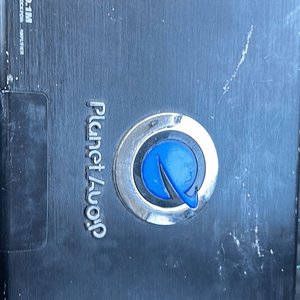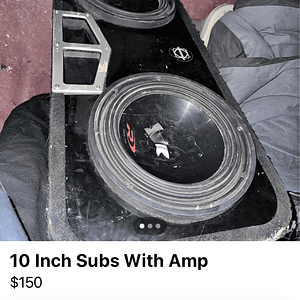geolemon 10+ year member
Senior VIP Member
Well, some people seemed to express interest in the Cyclone...
So I decided to disassemble mine, documenting what it is, and how it works.
//content.invisioncic.com/y282845/emoticons/fyi.gif.9f1f679348da7204ce960cfc74bca8e0.gifhttp://www.betteraudio.com/geolemon/cycloneinside //content.invisioncic.com/y282845/emoticons/fyi.gif.9f1f679348da7204ce960cfc74bca8e0.gif
The goal of that page is to explain more clearly "how they work".
I think the pictures, the disassembly, should help you understand it, if you are a bit unclear on what this thing is, and/or how it operates. //content.invisioncic.com/y282845/emoticons/cool.gif.3bcaf8f141236c00f8044d07150e34f7.gif
Here's a little head start:
What is it?
It is a rotary, servo-motor subwoofer. It consists of a flat panel, bisected by the output shaft of a DC servo motor.
A DC servo motor spins when fed DC electricity (DC, current moves in one direction). When fed AC electricity, such as the output of an audio amplifier (musical signal is alternating current), it will crank that shaft back and forth, waving the panel.
It uses two curved ramps inside a large cylinder to redirect the air being pushed by the waving panel in and out each end of the cylinder, allowing the Cyclone to stimulate the air just like a traditional subwoofer.
There has never been another rotary servo subwoofer that's been on the market, it is unique.
When was it made?
It was manufactured by Phoenix Gold beginning in the early/mid 90's, and sold until a few years ago when it was discontinued.
It's very Servo-Drive-like big brother, the Vortex (a rotary-to-linear motion converter enabled dual-15" cone monster), never made it to production.
Why would I want one?
There are many reasons.
One big one is efficiency:
Traditional voice-coil motors are about 1% efficient, while a servo-motor is about 10% efficient. So, 300 watts to this subwoofer is the equivalent of feeding a monster sub 3000 watts. Your electrical system is breathing easier already.
This also has the displacement of about three typical midgrade 12" subwoofers.
Another reason is sound quality:
If you've been following the forums the past year, you know the focus that's been put on producing subs that have "broad BL curves", so that as the cone's excursion level changes, BL remains constant... if BL does not remain constant, distortions will occur.
By nature, a servo motor can rotate a full 360 degrees without it's BL value even flickering. It has a literally infinitely flat BL curve.
Who made it?
While it was manufactured by Phoenix Gold, but it was co-designed by Tom Danley of Servo-Drive. Tom literally owns every patent that can be had on the concept of producing servo-motor powered loudspeakers... which might answer the question "why aren't there more loudspeakers like these?" //content.invisioncic.com/y282845/emoticons/wink.gif.608e3ea05f1a9f98611af0861652f8fb.gif
Tom used two of these in his own home reference system, for years.
So I decided to disassemble mine, documenting what it is, and how it works.
//content.invisioncic.com/y282845/emoticons/fyi.gif.9f1f679348da7204ce960cfc74bca8e0.gifhttp://www.betteraudio.com/geolemon/cycloneinside //content.invisioncic.com/y282845/emoticons/fyi.gif.9f1f679348da7204ce960cfc74bca8e0.gif
The goal of that page is to explain more clearly "how they work".
I think the pictures, the disassembly, should help you understand it, if you are a bit unclear on what this thing is, and/or how it operates. //content.invisioncic.com/y282845/emoticons/cool.gif.3bcaf8f141236c00f8044d07150e34f7.gif
Here's a little head start:
What is it?
It is a rotary, servo-motor subwoofer. It consists of a flat panel, bisected by the output shaft of a DC servo motor.
A DC servo motor spins when fed DC electricity (DC, current moves in one direction). When fed AC electricity, such as the output of an audio amplifier (musical signal is alternating current), it will crank that shaft back and forth, waving the panel.
It uses two curved ramps inside a large cylinder to redirect the air being pushed by the waving panel in and out each end of the cylinder, allowing the Cyclone to stimulate the air just like a traditional subwoofer.
There has never been another rotary servo subwoofer that's been on the market, it is unique.
When was it made?
It was manufactured by Phoenix Gold beginning in the early/mid 90's, and sold until a few years ago when it was discontinued.
It's very Servo-Drive-like big brother, the Vortex (a rotary-to-linear motion converter enabled dual-15" cone monster), never made it to production.
Why would I want one?
There are many reasons.
One big one is efficiency:
Traditional voice-coil motors are about 1% efficient, while a servo-motor is about 10% efficient. So, 300 watts to this subwoofer is the equivalent of feeding a monster sub 3000 watts. Your electrical system is breathing easier already.
This also has the displacement of about three typical midgrade 12" subwoofers.
Another reason is sound quality:
If you've been following the forums the past year, you know the focus that's been put on producing subs that have "broad BL curves", so that as the cone's excursion level changes, BL remains constant... if BL does not remain constant, distortions will occur.
By nature, a servo motor can rotate a full 360 degrees without it's BL value even flickering. It has a literally infinitely flat BL curve.
Who made it?
While it was manufactured by Phoenix Gold, but it was co-designed by Tom Danley of Servo-Drive. Tom literally owns every patent that can be had on the concept of producing servo-motor powered loudspeakers... which might answer the question "why aren't there more loudspeakers like these?" //content.invisioncic.com/y282845/emoticons/wink.gif.608e3ea05f1a9f98611af0861652f8fb.gif
Tom used two of these in his own home reference system, for years.


